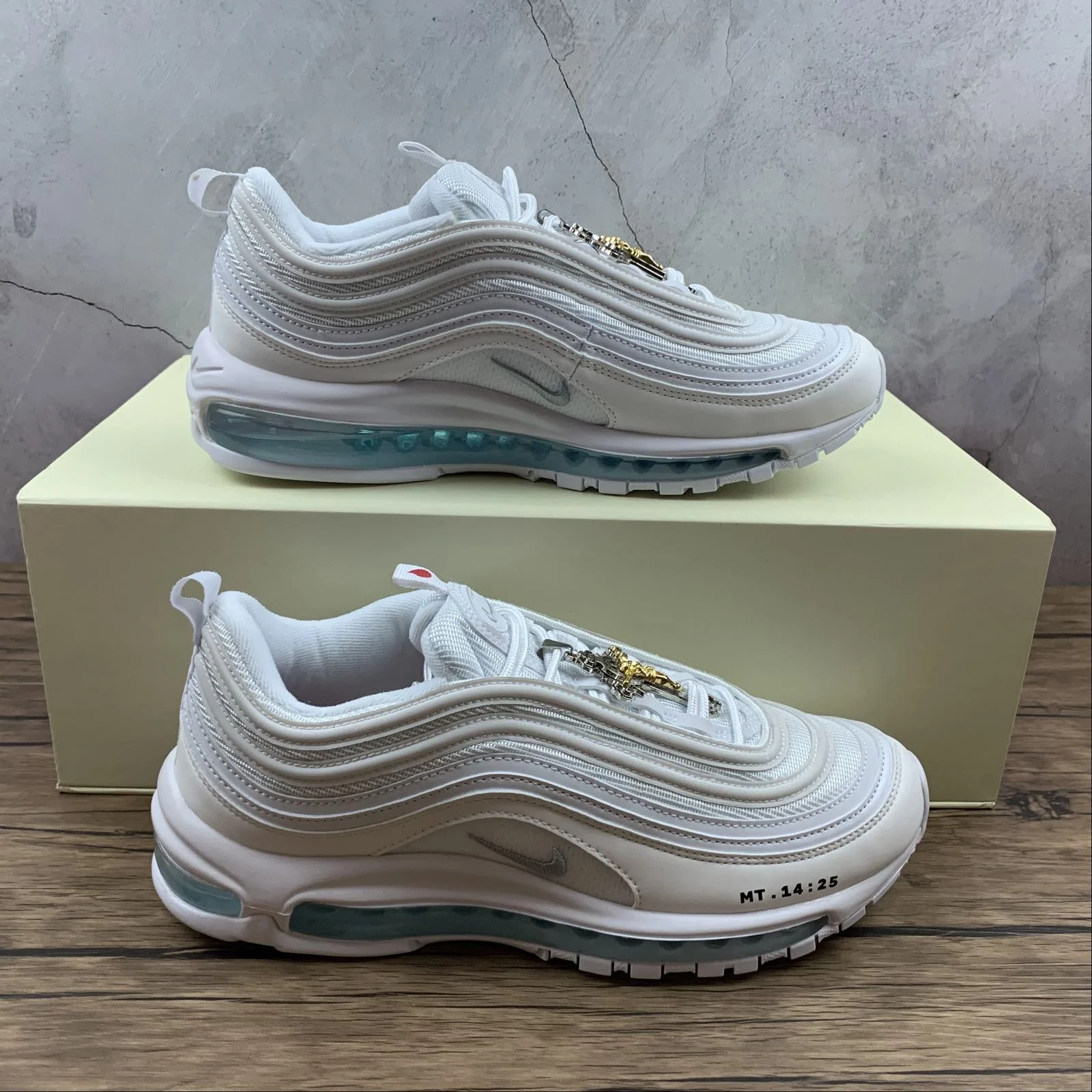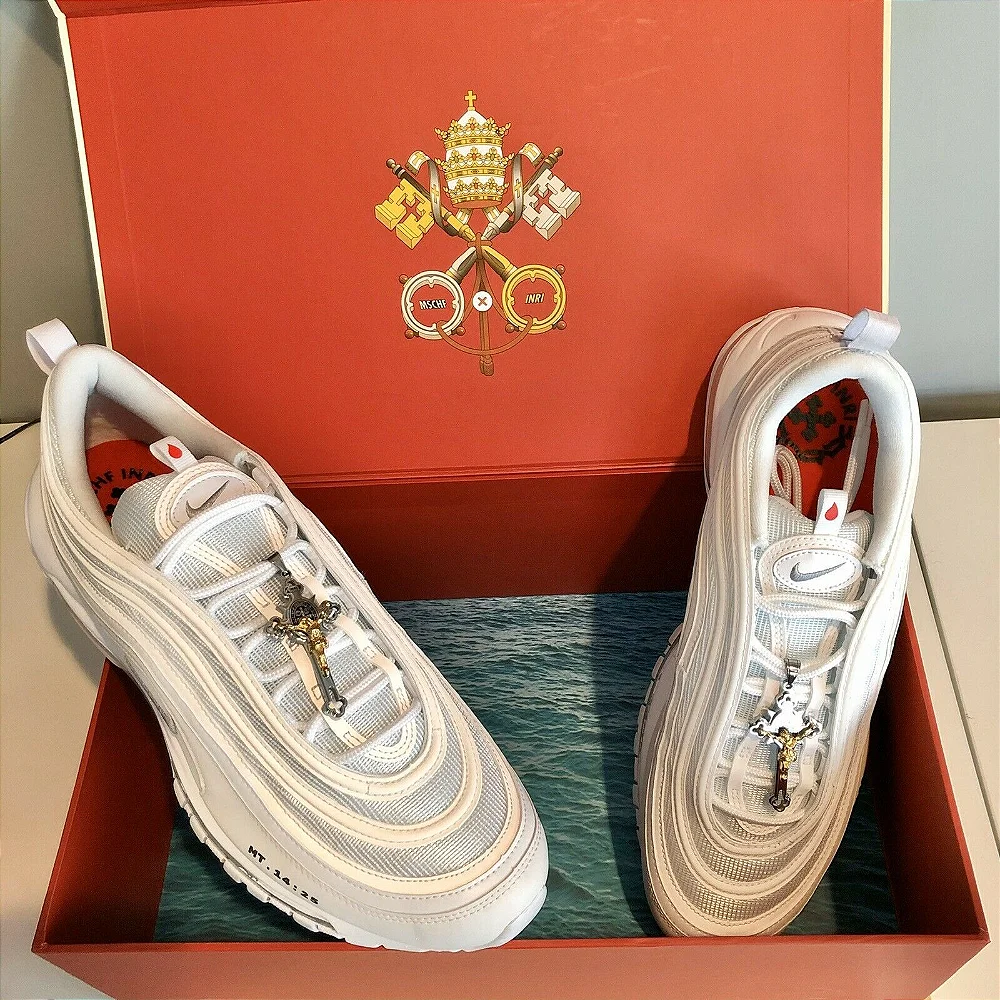In the world of sneaker culture, few releases have sparked as much intrigue and debate as the Nike Jesus Shoes. These unique sneakers not only feature a bold design but also incorporate deep religious themes. Released in 2019, they quickly became a sensation. But what exactly are these shoes? Why have they generated such a buzz? This article explores the origins, design, cultural impact, and ethical considerations surrounding the Nike Jesus Shoes.
Origin and Creation
The Nike Jesus Shoes originated from MSCHF, an art collective based in Brooklyn. They are known for their provocative projects that often critique consumer culture.
MSCHF wanted to critique the commercialization within the sneaker industry. To make their statement, they chose to customize the Nike Air Max 97 model. This was an iconic choice, already popular for its sleek design and comfort.
One of the shoe’s most striking features is the inclusion of holy water from the Jordan River, injected into the soles. This design element captures the biblical story of Jesus walking on water. MSCHF’s team went through several design iterations to get everything just right.
The intent was not just to create a striking visual. They also aimed to provoke thought and consideration. By integrating sacred elements into a commercial product, MSCHF blended art and religion in a new and challenging way.
To ensure the holy water was authentic, MSCHF contracted a priest to bless the water before injection. By adding this layer of authenticity, they aimed to respect the religious symbolism while still making a provocative statement.
Design Elements
The design of the Nike Jesus Shoes is meticulously planned. Each feature enhances the sneaker’s unique narrative.
- Color Scheme: The shoes are primarily white with light blue accents. White represents purity, while blue represents the holy water. This minimalistic color palette keeps the focus on the symbolic elements.
- Holy Water: The soles contain holy water from the Jordan River. This feature is more than a gimmick; it reinforces the miracle of walking on water.
- Religious Symbols: The laces are adorned with tiny crucifixes. There’s a red accent on the insoles symbolizing the blood of Christ. These elements add deeper meaning to the shoe’s design.
- Bible Verse: Inscribed on the side of each shoe is Matthew 14:25. This biblical passage talks about Jesus walking on water. It ties the design to its inspirational source while adding a contemplative aspect.
- Packaging: Even the shoebox is thoughtfully designed. It features angelic imagery and clouds, enhancing the heavenly theme. Unboxing becomes an experience in itself.
Every design choice contributes to making the Nike Jesus Shoes a piece of wearable art. These elements provoke thoughtful engagement from wearers and observers alike.
Cultural Impact and Reception
The release of the Nike Jesus Shoes generated a whirlwind of media and public attention. They became a viral sensation almost instantly.
- Media Coverage: Many news outlets covered the release extensively. Social media buzz added to the frenzy. Limited availability made these shoes highly coveted.
- Public Reaction: Opinions were divided. Some praised the shoes for their bold design and thought-provoking concept. Others criticized them as inappropriate, alleging that they commodified sacred symbols.
- High Demand: The controversy didn’t hurt sales. In fact, it probably fueled them. The shoes sold out quickly. On resale markets, prices skyrocketed.
- Celebrity Endorsements: Influencers and celebrities noticed the shoes. Their endorsements further increased the shoes’ visibility and desirability.
The cultural impact of the Nike Jesus Shoes extends beyond the sneaker community. They sparked meaningful conversations about art, religion, and consumerism.
The shoes became a hot topic not only in fashion circles but also in religious and ethical discussions. Some religious leaders were vocal about their disapproval, while others saw it as a unique intersection of faith and modern culture.
Philosophical and Ethical Considerations
The Nike Jesus Shoes raise important questions about the ethics of blending sacred elements with commercial products.
- Artistic Expression: From an artistic point of view, the shoes challenge norms and provoke thought. They blend sacred and secular worlds, making a strong statement.
- Commercialization of Religion: Critics argue that these shoes trivialize sacred symbols. Turning something holy into a consumer product can be seen as disrespectful. This criticism taps into broader concerns about the commodification of culture.
- Intent and Perception: MSCHF stated that their goal was to provoke thought, not offend. But public perception varies widely. Once released, interpretations become subjective and multifaceted. People view the shoes through their own cultural and personal lenses.
- Impact on Faith Communities: Reactions among faith communities were mixed. Some saw the shoes as innovative and meaningful. Others found them disrespectful. This split highlights the delicate balance needed when using religious themes in art and commerce.
These considerations deepen our understanding of the Nike Jesus Shoes. They show how art, religion, and commerce intersect in complex ways.
The shoes have inspired other artists to explore similarly provocative themes. They serve as a case study in how art can push boundaries and provoke meaningful dialogue.
Historical Context
To fully appreciate the Nike Jesus Shoes, it’s essential to consider the historical context of sneaker culture and religious symbolism.
Sneaker culture has evolved dramatically over the years. Initially, sneakers were designed purely for athletic purposes. However, they have since become cultural symbols, representing identity, status, and artistic expression. Limited-edition releases and exclusive collaborations have turned sneakers into coveted items, often reselling for exorbitant prices.
Religious symbolism in art has a long history. Artists have used religious themes to convey messages, provoke thought, or critique societal norms. The integration of such symbols into consumer goods reflects both the changing landscape of art and the increasing commodification of culture.
The Nike Jesus Shoes are a product of this evolving cultural landscape. They merge the modern obsession with limited-edition sneakers with timeless religious themes, creating a dialogue between the past and the present.
These shoes also reflect how brands and artists are increasingly willing to take risks in their designs. They push the envelope to create conversations and draw attention in a crowded market.
Technological Innovation
The creation of the Nike Jesus Shoes also involved technological innovation. Injecting holy water into the soles required precise engineering to ensure durability and functionality.
Advancements in sneaker technology have enabled designs that were previously unimaginable. From self-lacing shoes to sneakers that track your movement, technology plays a crucial role in modern footwear design.
MSCHF’s innovative approach with the Nike Jesus Shoes demonstrates the possibilities when technology and creativity collide. It pushes the boundaries of what sneakers can be, transforming them into platforms for artistic and philosophical exploration.
The engineering involved in injecting and sealing the holy water without compromising the shoe’s functionality exemplifies the advances in sneaker technology. This blend of art and engineering is a testament to the innovative spirit driving today’s sneaker culture.
Cultural Legacy
The legacy of the Nike Jesus Shoes will likely endure for years to come. They have set a precedent for future collaborations and artistic endeavors within sneaker culture.
These shoes have inspired other artists and designers to experiment with bold, provocative themes, challenging conventional norms. The conversations they have sparked about art, religion, and consumerism will continue to resonate, influencing future projects and cultural discussions.
In many ways, the Nike Jesus Shoes encapsulate the essence of our times—a blend of technological innovation, artistic expression, and cultural commentary. They remind us that even everyday objects like sneakers can carry profound meaning and spark important conversations.
Future releases inspired by the Nike Jesus Shoes may continue exploring the intersection of technology, religion, and consumerism. These explorations could lead to new forms of artistic expression and cultural critique.
Comparisons to Other Art-Inspired Sneakers
The Nike Jesus Shoes are not alone in their attempt to blend art with sneaker design. Other collaborations have also sought to bring artistic themes to footwear.
For instance, the “KAWS x Air Jordan” collaboration brought the world of contemporary art into the sneaker realm. These shoes also became instant collectibles and sparked conversations about the role of art in consumer goods.
Similarly, the “Off-White x Nike” collection by Virgil Abloh deconstructed classic Nike models, treating them as canvases for artistic expression. This collaboration redefined sneaker design and opened new avenues for artistic exploration.
Compared to these collaborations, the Nike Jesus Shoes stand out for their bold use of religious symbolism. While other art-inspired sneakers focus on aesthetics and design innovation, the Nike Jesus Shoes provoke deeper philosophical and ethical questions.
These comparisons help highlight the unique position that the Nike Jesus Shoes occupy within both the art and sneaker worlds. They serve as a bold statement at the intersection of these two realms.
 Conclusion
Conclusion
The Nike Jesus Shoes are much more than a pair of sneakers. They are a provocative statement that challenges our perceptions of art, religion, and consumer culture. From their creation by MSCHF to their controversial reception, these shoes encapsulate the complex interplay between creativity, symbolism, and commercialization. By exploring the various facets of the Nike Jesus Shoes, we gain a deeper understanding of the cultural and philosophical questions they raise. These shoes aren’t just about making a fashion statement. They are about sparking conversations that resonate far beyond the sneaker community.
In understanding the impact and legacy of the Nike Jesus Shoes, we see how they have pushed the boundaries of what can be achieved with a pair of sneakers. They encapsulate the evolving role of sneakers in modern culture, transforming them into powerful symbols of artistic and cultural expression.
The Nike Jesus Shoes challenge us to think about the intersections of faith, art, and commerce. They remind us that even everyday objects can carry deep meaning and provoke significant cultural dialogues. Through these shoes, we see the power of innovative design and thoughtful symbolism in sparking important conversations.


